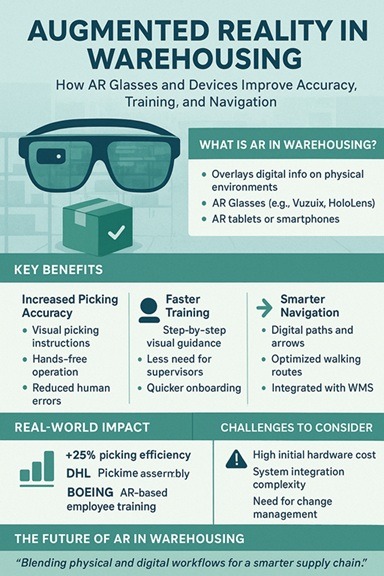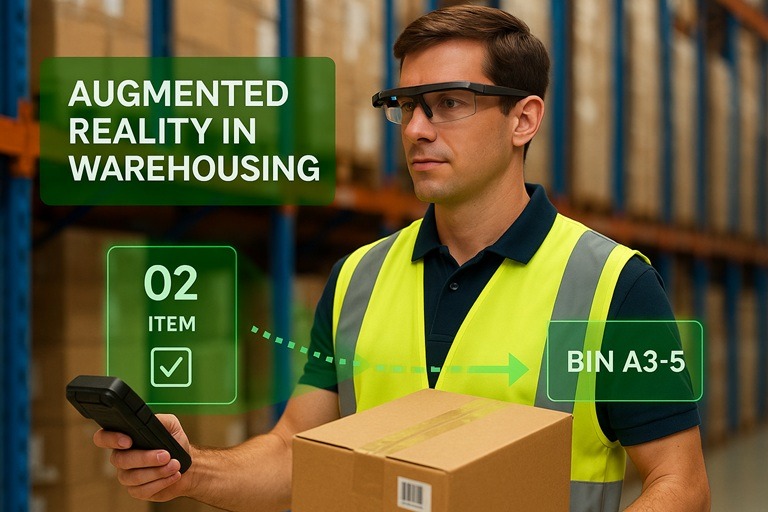
Augmented Reality Warehousing: Revolutionizing Efficiency and Accuracy
As warehouses evolve to meet the demands of faster order fulfillment and higher accuracy, Augmented Reality (AR) is emerging as a transformative technology. By overlaying digital information in the real world through AR glasses and handheld devices, warehouse operations can be streamlined to boost productivity, reduce errors, and shorten training times. In this article, I explore how AR is revolutionizing key functions such as picking, training, and navigation inside the warehouse.
Boosting Picking Accuracy with Augmented Reality
Order picking is a critical warehouse task, but human errors can lead to costly mistakes. We have written at large about ways to optimize picking with a proper WMS with digital devices, and scanners. But AR glasses, such as those from companies like Microsoft (HoloLens) or Vuzix, address this by providing real-time visual guidance. Workers see digital overlays highlighting item locations, quantities, and product details directly in their field of vision. For example, an AR headset might display a glowing arrow pointing to the correct shelf or flash a warning if the wrong item is picked. Studies suggest AR-assisted picking can reduce error rates by up to 40%, minimizing returns and improving customer satisfaction. By freeing workers from handheld scanners or paper lists, AR also speeds up the process, allowing warehouses to handle higher order volumes efficiently.

Accelerated Training and Upskilling
Training new warehouse employees can be a time-consuming and resource-intensive process. The complexities of warehouse layouts, diverse product types, and intricate picking procedures often lead to a steep learning curve. With AR-powered training modules, new hires can experience interactive simulations directly within the warehouse environment. Instead of relying solely on manuals or shadowing experienced staff, AR glasses can overlay step-by-step instructions for tasks like order picking, equipment operation, and safety protocols. This “on-the-job” virtual guidance allows employees to learn by doing, receiving real-time feedback and corrections. This immersive and engaging approach not only reduces training time but also improves knowledge retention, ensuring a more skilled and confident workforce from day one.
Improving Navigation and Workflow Efficiency with Augmented Reality
AR-powered navigation assists workers in finding optimal routes through complex warehouse layouts. When wearing AR glasses, workers can see arrows and path indicators guiding them to the next location, minimizing unnecessary walking and improving productivity. This can be particularly valuable in large fulfillment centers or multi-level facilities. By integrating AR with warehouse management systems (WMS), the technology can dynamically adjust routes based on priorities, traffic in aisles, or urgent tasks, optimizing both space and time.
Augmented Reality in Action: Real-World Results
Several early adopters in retail, automotive, and e-commerce sectors are already reaping the benefits of AR:
- DHL Supply Chain piloted AR-assisted picking in warehouses across Europe and reported a 25% increase in picking efficiency.
- Boeing uses AR in its manufacturing and parts logistics to guide workers through complex assembly tasks with real-time 3D instructions.
- Walmart has explored AR glasses for employee training, enhancing skill retention and confidence in new roles.
These cases show that AR is not just a futuristic concept—it’s a practical, proven solution ready for wider adoption.
Challenges and Considerations
Despite its promise, AR adoption comes with challenges:
- Hardware costs can be high, especially for large teams.
- Integration with existing WMS and ERP systems requires planning and development.
- Change management is crucial to ensure user acceptance and ROI.
However, these barriers are steadily lowering as AR hardware becomes more affordable and platforms more interoperable.
Conclusion: A Clear Vision for the Future
Augmented Reality in warehousing is moving from pilot to practice. With the ability to improve picking accuracy, reduce training time, and optimize navigation, AR offers a compelling value proposition for logistics and distribution centers looking to stay competitive in an increasingly fast-paced environment.
As AR continues to mature, its role in warehouse automation and human-technology collaboration will only grow, blurring the lines between physical and digital workflows for a smarter, more efficient supply chain. Laceup solutions can adapt to whatever strategy you decide on. If you want to learn more about our solutions, contact us.
I hope this article has been helpful to you. I will continue to post information related to management, distribution practices and trends, and the economy in general. Our channel has a lot of relevant information. Check out this recent video on ” To Increase Picking Accuracy”.


Sorry, the comment form is closed at this time.